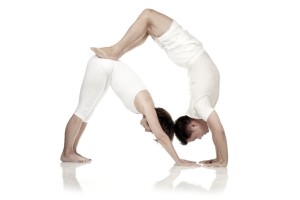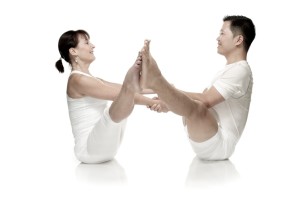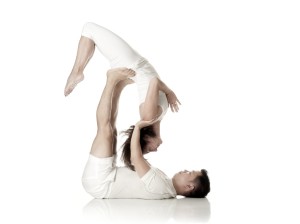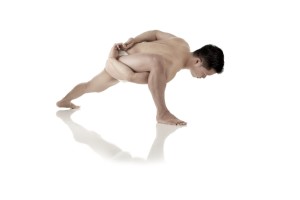Click here for: Wellness Program l Yoga l Research & Studies
Have you been thinking about trying out yoga for a while or you just want to be more calm and Zen in your hectic life? Have you been hearing about how much some people love yoga and that it makes them feel great, is a good way to lose weight or that for some it’s been a life changing experience? What ever your motives are, this article will give you some ground rules, and help make your introduction to yoga a more enjoyable experience.
There are different types of yogas: Ashtanga yoga (yoga flow) which is more challenging than Iyengar or Hatha (a slower yoga); kundalini, which is more back/spine work, where you get to chant; the controversial hot yoga (developed from Ashtanga / Hatha) where you do it in a heated room and sweat like no tomorrow; personal branding in a studio or gym where they use their own name for their own type of yoga.
Yep, yoga has become a big biz and it has out-sold coca cola
Trying it out…

Depending on your physical ability there are 5 levels in yoga, so actually everyone can do it. Make sure you have a proper warm up at the beginning or conditioning of your body for the poses. Keep in mind that the more flexible you are the greater risk you have of becoming injured. Yoga is about strengthening, mastering and controlling your muscles.
First, we need to figure out what your objectives are?
Why do you want to start practicing yoga?
Do you want to lose weight?
Strengthen your body muscles?
or just want to try something new?
Before you spend any money buying a mat, paying for yoga classes and buying the clothes, try some yoga classes first to see if it is some thing that you like. Look for free classes at the gym. Studios usually give out a free 1st trial class or you can get a one-week unlimited class. Try out at least 3 to 5 classes before you decide if you like it or not.
Your 1st class: there are an assortment of different exercises and breathing techniques and lots of information – you may find it over- whelming!
2nd class: you may be able to follow half of the class and still find yourself lost for the other half.
3rd to 5th classes: you are going to be able to do the actual yoga and able to follow and know where the class is going. At this point, you can judge to see if you like yoga or not. Then you can decide to pay for a studio or gym membership.
Try to avoid trying out yoga with a DVD or series on TV. These are only great if you already know what you are doing (or if there are no yoga class near you,) but it is better to have an experienced yoga instructor keep an eye on you at the start in order to prevent you from getting injured or doing pose that your body is not conditioned for. Yoga has many great benefits, but if your body is not conditioned for the poses that gradually build up to the more advanced poses or if you do not warm up properly – it also can be dangerous.
Spending your hard earned money..
Let’s say that you’ve tried yoga and like what its does and now you want to look for a yoga class in a studio or gym.
Here’s what you want to look for in a class:

Classes that are not too packed, with an average of 10 people or less. If there’s more than that, the yoga instructor cannot keep an eye on everybody. This is even more important if it’s a beginner class in order to prevent injuries. Yoga consists of a lot of structure and each pose is a gradual build-up to open up your muscles and internal organs. You don’t want to start by doing a standing upside down pose or a full back bend at the beginning of a class. Similar to lifting weights, you would not likely start with a 300 lbs. weight bench press when you haven’t built-up your muscles. Yoga is no different. Ensure that you have an instructor that is able to keep an eye on the class and each individual gives lots of explanation.
One of the misconceptions people have about yoga is that it is merely stretching. However, there is no stretching or pulling on any muscles. Instead it involves using muscles to control body movement and hold poses in place, which strengthens the body and gets your heart rate going. Mastering your body involves obtaining control over every muscle and every movement, even in active relaxation. This is the art of yoga.
What you want to look for in a yoga teacher?

Does he/ she expand the posture properly? If you are new to yoga, this information will help you to do the actual yoga pose and get its full benefit, instead of posing in the pose. This also gives you a good foundation for your practice and prevents future injuries.
Does he/she explain what the pose is for? Example: how to control your lower back and what muscles are you working on?
If you have a lot of special needs or injures, you may want to consider private lessons or doing yoga therapy once you’ve decided that yoga is something you would like to do.
Does the teacher walk around the class making sure you are doing the poses properly, give corrections and keep an eye on the class?
Breathing is very important in yoga! It helps open up your muscles, calm your body and relax your nervous system. Breathing can also help speed up your heart rate or slow it down. There can be cardiovascular work in all your poses. Your instructor should have a good rhythm, depending upon whether he/she wants to warm your body up or calm your mind down for relaxation.
Yoga has many benefits, both physical and emotional. Just like studying English/poetry, the poses are your basic abc’s. The interpretation and use of each yoga pose to balance your yin/yang, front/back and masculine/feminine are all based upon the teacher’s knowledge and experiences.
A good yoga class will give you a feeling of centred-ness and that your muscles have been worked. Your mind will be calm and your body will feel strong. It is not the same feeling as when you have been sitting in a sauna for 30 minutes, when you come out feeling relaxed but also limp or light headed.
If by the end of the class you feel discomfort, which means there is something that’s gone wrong in the class. You may have pulled something or put too much pressure on your body. Let the teacher know.
Relating to your yoga instructor.
If you like yoga and now want to find a teacher that you can communicate with and who will assist you to the best of your ability in your practice.
What type of personality do you have? Are you an auditory person? Do you need to hear every instruction explained clearly? A visual person needs to see everything demonstrated before or during the pose. Or are you a person who needs to feel what you are doing to be able to understand the poses.
Know what your personality trait is and look for an instructor who demonstrates all three of these traits, or at least one with the same trait as you have.
Objective of practicing yoga:

Yoga is used to achieve clarity, center, calm the body and mind by using poses to open up the body and release all physical (muscles/ tension/ stiffness) and internal tension (internal organ/ blood circulation), and to master the muscles. It is also used to prepare the practitioner for spiritual worship, karma sutra practice or to just enjoy the calming of the body and mind.
Remember that flexibility comes from strengthening your muscles,not the other way around. You need to be strong and able to control your muscles before you achieve flexibility in yoga. The more flexible a person is, the more likely they will injure themselves in yoga.
There you have it.
Good luck and go out and bend it like a pretzel!